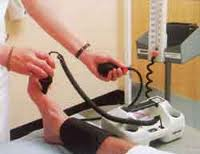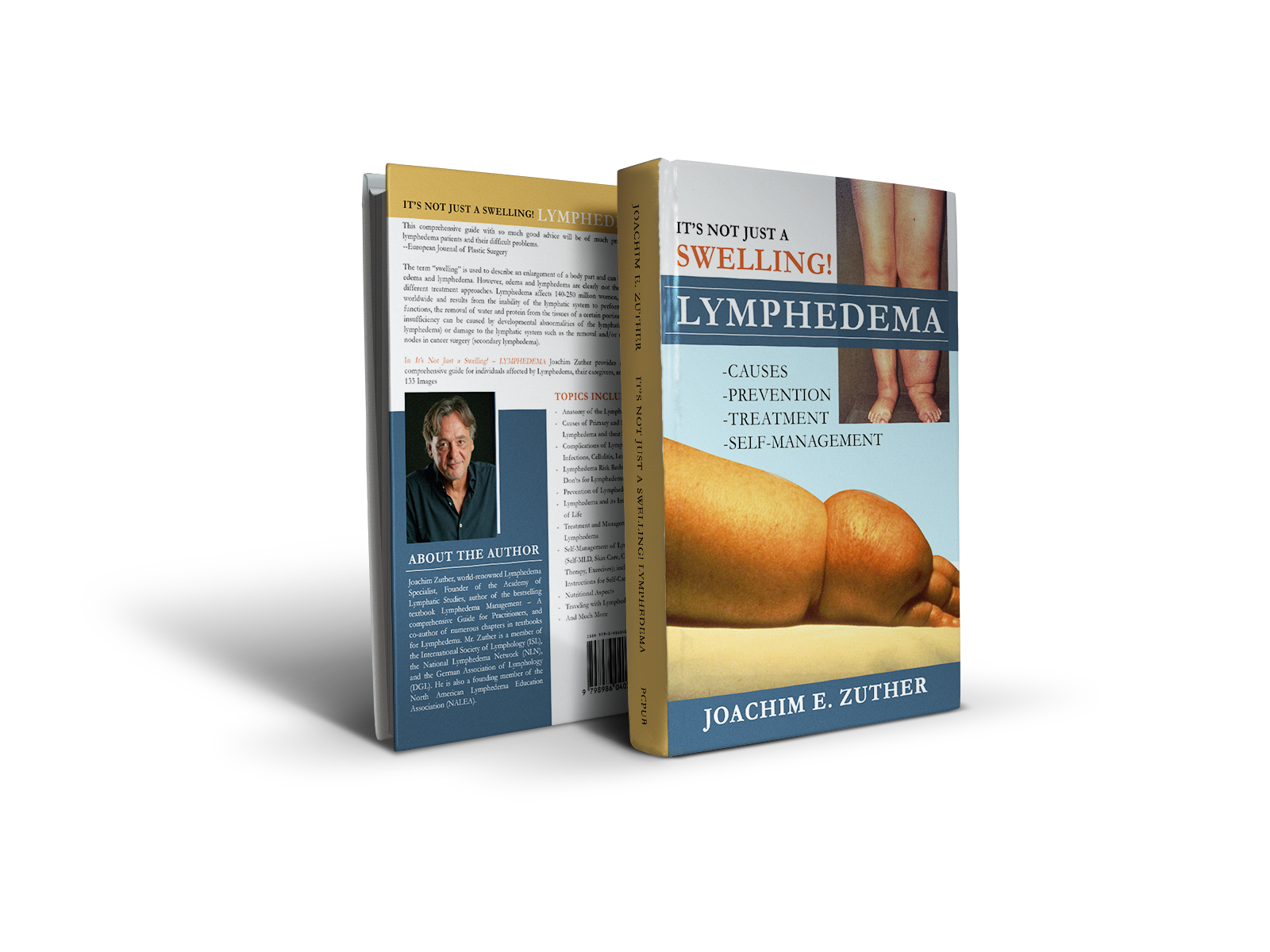The surgical procedures performed on individuals affected by breast cancer may be mastectomy, partial mastectomy, or lumpectomy. Along with the actual breast surgery for cancer, axillary lymph nodes are removed and/or radiated. As a result of axillary lymph node clearance, the normal lymphatic drainage from the extremity is impaired, and some patients experience the onset of lymphedema. Accumulated lymph in the edematous arm provides a rich culture medium for bacteria, which makes lymphedematous  tissues very susceptible to infections. Simple injuries and puncture wounds can develop into local or generalized infections that may produce further lymphatic destruction and blockage. To reduce the risk of these postoperative complications, most patients are advised to not have blood pressure readings taken on, intravenous infusions in, or blood samples taken from, the arm on the operated side.
tissues very susceptible to infections. Simple injuries and puncture wounds can develop into local or generalized infections that may produce further lymphatic destruction and blockage. To reduce the risk of these postoperative complications, most patients are advised to not have blood pressure readings taken on, intravenous infusions in, or blood samples taken from, the arm on the operated side.
Very little published data are available to document the exact risk of lymphedema from performing blood pressure readings, blood draws and injections on the affected extremity. Lack of research and normal variations in each individual’s lymphatic system (numbers or sizes of remaining lymph nodes) make it difficult to quantify personal risk from each triggering factor. Recently published articles on risk-reduction practices in reputable journals may conclude that risk reduction practices are overrated and/or no risk reduction behaviors are needed for lymphedema. This is incorrect! – Dr. Nudelman, an Associate Professor of Family Medicine and co-founder of stepupspeakout (www.stepup-speakout.org) wrote an article discussing these recent attempts to debunk risk-reduction for lymphedema. Read Dr. Nudelman’s response to these articles here.
While further research is needed, healthcare professionals are encouraged to minimize the risk of lymphedema by taking blood pressure readings,  blood draws and injections on the non-affected limb whenever possible. In patients with breast cancer on both sides, these procedures should be performed on the leg or the foot. If this is not possible, the procedure should be done on the non-dominant arm. If one side had no lymph node removal, the arm on that side should be used, regardless of whether it is the dominant arm. In an emergency, however (such as a car accident), or if a medically necessary procedure (such as a CT or MRI) needs to be performed, and an intravenous line must be started, medical professionals must be allowed to do what they need to do to start the intravenous line as soon as possible, even if it would involve the affected extremity.
blood draws and injections on the non-affected limb whenever possible. In patients with breast cancer on both sides, these procedures should be performed on the leg or the foot. If this is not possible, the procedure should be done on the non-dominant arm. If one side had no lymph node removal, the arm on that side should be used, regardless of whether it is the dominant arm. In an emergency, however (such as a car accident), or if a medically necessary procedure (such as a CT or MRI) needs to be performed, and an intravenous line must be started, medical professionals must be allowed to do what they need to do to start the intravenous line as soon as possible, even if it would involve the affected extremity.
If a port is present, blood draws should be taken directly from there. In patients with “bad” veins, good hydration and some form of heat (heat pads, warm water) help to dilate the veins prior to cannulation.
To avoid the onset of lymphedema, or infections in existing lymphedema, health care professionals should follow expert consensus regarding best practices to avoid lymphedema and inform patients with breast cancer about their risk factors for developing lymphedema. While research suggests that the risk of complications resulting from blood draws or intravenous injections on the affected extremity is low, there IS still a risk, which is avoidable.
Not all medical professionals are familiar with the precautions for avoiding lymphedema, so patients have to be especially watchful advocates for themselves.
Further reading on the topic is available here:
National Lymphedema Network
National Cancer Institute
Mayo Clinic
National Institute of Health/PubMed
National Institute of Health/PubMed
Dear Lymphedema Blog Reader – if you like the contents on this website, please help to keep it going. A great amount of work and research is necessary to provide you with up-to-date information on this site. Your donation supports these efforts and associated administrative costs. Surplus funds will be donated to Lymphedema/Lipedema-related charitable endeavors. Please donate using the “Donate Now” button on the right upper hand of this page – Thank You!
Join Lymphedema Guru, a Facebook page solely dedicated to inform about all things related to lymphedema – news, support groups, treatment centers, and much more


 Joachim Zuther, Lymphedema Specialist.
Joachim Zuther, Lymphedema Specialist. 

Excellent webpage, useful source of info
I have learned so much on the internet over the past few years. The majority of it I can attribute to reading well thought out and educating blogs like yours. Thank you for it.
I like https://www.lymphedemablog.com. Keep up the great work!Thanks.
I am not going to lie this really is one of the very few sites I really enjoy reading and it’s due to top quality information such as this. Keep up the great job, these are definitely very helpful posts.
Thank you very much for your post! Very interesting information
I think this is very important. Thanks a lot.
Used to do it, dropped 24 pounds, currently a size 4 and loving it, I actually do not regret it at all, I have strength right now to sort out and keep the weight off, I was monitored by a physician, the only real modifications I encountered were favorable, nearly a year afterwards I still feel and look excellent and my wellness has never been better.
Thank you. I was diagnosed with primary le in the legs 10 years ago. It was only visible during summer. Due to a little accident, one leg got worse. Although I have same diagnosis on both legs through lymphescintography, now it is only really visible in one leg. I had lymphescintography done in my arms because I am thinking of a lymph node transfer. It showed that I have less nodes then normal in both arms too, and that the uptake is really slow… When I read this post I wonder what limb to choose. There is nothing to see in both arms.. in fact I am really skinny, sporty and young. Thank you
I also love this side and learn allot about lymph edema!!
What were the references that you used for your blog on venipuncture on the mastectomy side? Thank-you.
http://books.google.com/books?id=cHAjsUgegpQC&pg=PA26&lpg=PA26&dq=venipuncture+and+mastectomy&source=bl&ots=qwRHpwysI5&sig=UxhM9v5Cq5GgDUqUaBAd8GAVvtA&hl=en&sa=X&ei=ryivUryzF8W4kQe39oDIBQ&ved=0CE4Q6AEwATgK#v=onepage&q=venipuncture%20and%20mastectomy&f=false
Love your website, keep up the good work and posting relevant info to all Lymohedema sufferers, I live in Ireland and here they pay little or no importance to this condition, so, we all depend on dedicated people like yourself to keep us informed. Thank you keep the info coming M arie Norman
With Lymphedema in both arms for 39 years surviving, and age 92, I am still sent home from emergency room after a bout of cellulitis as they refused to take blood or B/P from my foot. My doctor scrips for them to take my blood from my foot and they refuse. Even the ambulance EMT won’t take B/P from my leg. Can you send directions again on taking blood samples from my right foot
Thank you for any help…
I went to the ER yesterday with chest pains and it ended up being gallstones. Long story short, for several hours i was hooked up to a blood pressure machine on the arm where 13 lymph nodes were removed. I had a double mastectomy last year due to invasive lobular carcinoma. I haven’t had any problems in that arm and now I am scared to death. And I don’t know what to do. Under my arm this morning and today has been really numb. Is there anything I can do to prevent lymphedema? Any suggestions would be helpful. I was even wondering if the sleeves would be helpful? Thank you for all you do.
Tammi: Wearing a compression garment is one way to prevent the onset of swelling. Here is a link to an article that may be of interest to you: https://www.lymphedemablog.com/2013/10/15/dos-and-donts-for-lymphedema-of-the-arm/
Hello I am a 70% Service Connected Army veteran, with Bilateral lymphedema in my legs. This is due to a surgery and many repeated cellulitis infections. Can you tell me if there is any studies or findings of Chronic Lymphedema effects on hypertension (high blood pressure). I did not have hypertension before all of this and now they can not control it. I am a 26 year sufferer of this condition.
Robert – there is no known direct connection between lymphedema and hypertension
Very useful information shared by you. Yes, I agree precaution is better than cure.